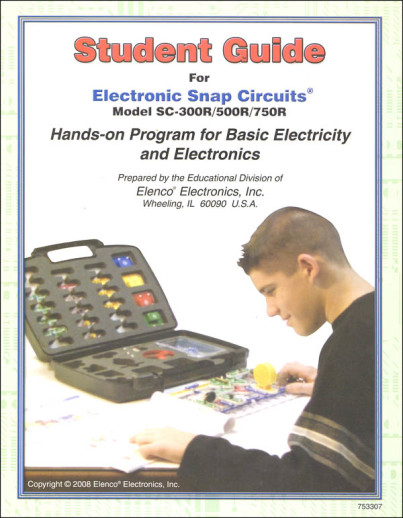We use cookies to make your experience better. To comply with the new e-Privacy directive, we need to ask for your consent to set the cookies. Learn more.
Snap Circuits Student Guide SC-300R/500R/750R
Unless a child has a burning interest in electricity, I'm guessing that they're not going to pore over the Snap Circuits experiment guides and really learn why a project works before they assemble it. When the excitement wears off, however, they may be interested to learn more about electricity. Or maybe you may just want to incorporate that Snap Circuits set in with what you're studying in physics. To make it easier to do both of those things, there are two Student Guides and a comprehensive Teacher Guide available for the core Snap Circuits sets. The student guides are full-color and present a variety of electricity topics based on the projects and parts included in that particular kit. For example, the Student Guide for the 100-Experiment Snap Circuits set includes four chapters: Basic Components & Circuits, Motors & Electricity, Resistance, and Electronic Sound and Integrated Circuits. Each chapter is made up of color-coded boxes of text. Core information is blue, experiments (which reference the experiments in the Snap Circuit set's activity guide) are green, yellow is for introducing electronics parts, orange is for advanced material, and brown is for additional/background material. Each chapter ends with "quick quiz" assignments, practice problems, and a bulleted summary of important concepts. The end of the guide holds definitions for electrical terms and components. Although originally there was one student guide per kit, the manufacturer has combined the student guides for the 300-Experiment kit and up, so now there is a 100 Experiment Guide and a 300/500/750 Experiment Guide. All in all, the guides do a great job of "filling in the gaps" informationally, while using the Snap Circuits set as a basis. There is only one Teacher Guide, which covers all of the Snap Circuits sets. The Teacher Guide holds some parent/teacher information, a table of contents for each of the Student Guides, reproducible quizzes for each Student Guide, and answers for the quizzes. What a great and easy-to-use resource to delve a little bit deeper into those electricity concepts! - Jess
| Product Format: | Softcover Book |
|---|---|
| Grades: | 3-AD |
| Brand: | Elenco |
| Length in Inches: | 11 |
| Width in Inches: | 8.5 |
| Height in Inches: | 0.25 |
| Weight in Pounds: | 0.7 |


Using this to create a circuits class for my daughter that has a bunch of Snap Circuits and is very interested in circuits.
Our Ham Radio Club has the SC300 model but not the student guide
We bought our son a snap circuit board and this will make it more of a learning experience to go along with the fun
I own the 500 set and need more in-depth understanding of the projects.